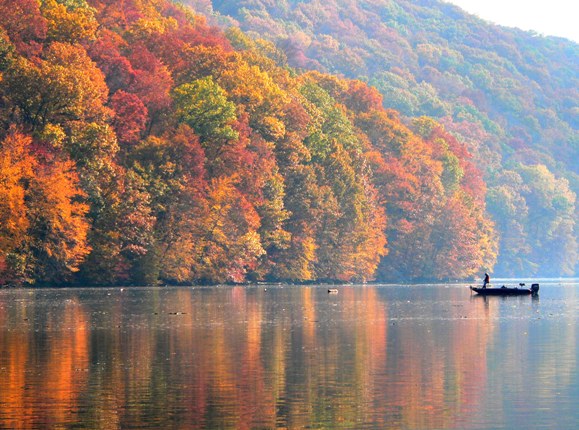
Mother Nature is kind to Canadian bass anglers in the fall, giving them some of the finest fishing of the season. And you can make it even better by remembering these eight simple rules.
1. Strike zones shrink
Think of autumn as having three separate sub-seasons: early fall, Indian summer and late fall. Throughout this time of year, diminishing daylight and dropping water temperatures prompt both large- and smallmouth bass to binge feed to survive the winter. But the more the daylight wanes and the water cools, the shorter the distance the fish will swim to strike a lure. In other words, bass that will scoot 20 feet to hit a bait floating above their heads in early fall won't move two feet to eat a jig in late fall just before freeze-up.
2. Baitfish go deeper
Bass always follow baitfish, but this becomes all the more evident in the fall, when their prey moves ever deeper, seeking stable water conditions. Early in the season, for example, you may find smallies marauding schools of shiners, smelt and ciscoes in 10 to 20 feet of water. But just before the ice forms, you'll likely find those same predators and prey in water twice that depth. That's why your odds increase if you only fish spots where you first see bait on your sonar.
3. Largemouth migrate differently
Instead of migrating vertically, as their smallmouth cousins do, largemouth bass tend to travel horizontally in the fall. In early autumn, they will vacate the backs of shallow bays and set up shop on secondary points before moving to primary lead-in points. Largemouth that spend the summer deep in the grass, on the other hand, typically move to the outside edges of the deepest weedlines, where they're suckers for a vertically falling jig-and-pig presentation.
4. Cranks catch cruisers
During early fall and Indian summer, giant largemouth love to cruise along the gently sloping rock, gravel and boulder shorelines that abut primary points. These hard-bottomed areas always produce better than fast-breaking, steep shorelines. The key is to select a crankbait that dives deep enough to occasionally dig into the bottom and bounce off rocks and logs.
5. Drifting finds bronzebacks
When you're fishing for open-water, structure-oriented smallmouth in the fall, let the wind guide you. Drift across prime rocky structures while dragging a drop-shot rig, tube jig or Carolina rig tipped with a soft-plastic grub or minnow. Just remember that as the season progresses and the water cools, you may need to throw out a drift sock or use your electric trolling motor to slow your presentation to a crawl.
6. Float 'n' flies fool smallies
Once the water temperature drops below 10ºC (50ºF), use an eight- to 10-foot spinning rod to deliver a tiny craft hair jig resembling a minnow native to the lake. Set a small fixed float six to 12 feet above the jig so it will suspend in front of the fish's nose. The colder the water, the better the float 'n' fly produces on smallmouth.
7. Largemouth follow greenery
Just before freeze-up, most of the vegetation in the lake will have withered up and died, turning a scummy brown colour. The largemouth will vacate this sorry-looking vegetation in favour of the last remaining patches of green grass. Find the few lingering clumps of greenery and you'll discover nearly every largemouth left in the lake. The cold-water action will be so hot, in fact, you'll have to pinch yourself to make sure you're not dreaming.
8. Topwaters still produce
Too many bass anglers think topwater lures are restricted to the warm summer months. Big mistake. In early fall and during balmy Indian summer days, a topwater can cause the biggest bass to become unglued. Better yet, while topwaters are often considered early-morning and late-afternoon producers in the summer, they'll entice bass all day long in the fall. And that's just one more way to take advantage of the finest bass fishing of the year.





